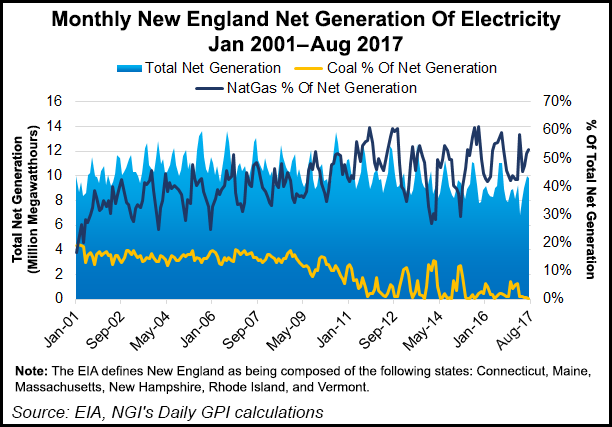NGI The Weekly Gas Market Report | Infrastructure
ISO-NE CEO Says Regional NatGas Demand Increasingly Outpacing Supply
New England’s natural gas infrastructure has not kept pace with the increasing demand for power generation, a top regional executive told the Energy Council of Rhode Island at a forum this month.

ISO New England Inc. (ISO-NE) CEO Gordon van Welie said there aren’t enough interstate pipelines and liquefied natural gas (LNG) delivery points to match projected demand. The region’s pipelines, he said, were built to serve heating demand, not power generation. As a result, capacity is running at or near maximum during the winter. The grid operator has been calling for supply enhancements for years.
As in other parts of the country, New England has seen a dramatic change in its energy mix. Natural gas generated 15% of the region’s electricity in 2000; today it generates the largest share at 49%. Coal-fired plants that once generated 18% of the region’s electricity now generate 2%, while renewable generation has only grown during that time by 2% from 8% to 10%. Nuclear and hydro primarily provide the rest.
Seven power plants across the six-state region that generate electricity using either oil, coal or nuclear resources are scheduled to close by 2019, eliminating 30% of the region’s generating capacity by then, according to the energy council.

LNG imports have historically met a significant portion of demand in the region, but they have declined because of various conditions, such as demand from other markets and expiring contracts. Pipeline capacity in the region is often reserved by local distribution companies on the coldest winter days, leaving little leftover gas for power generators that don’t have firm transportation secured. The constraints have made New England’s electricity costs some of the country’s highest.
The retirements are attracting more resources such as natural gas and renewable facilities, but van Welie said policymakers could do more to address the problem by investing in renewable energy or gas infrastructure. He also said the region could permit more oil to be used in the winter. New England, however, has generally been resistant to shipping in more gas via pipeline.
ISO-NE is currently conducting a study of fuel security challenges. It won’t focus on the effects of expanded access to gas, van Welie said, and it won’t identify the needs for expanded pipeline capacity.
Instead, the preliminary results are to be presented to regional stakeholders for input. ISO-NE would then work with the stakeholders to determine whether more operational or wholesale market design measures would be needed to address fuel security risks.
© 2024 Natural Gas Intelligence. All rights reserved.
ISSN © 1532-1231 | ISSN © 1532-1266 |
